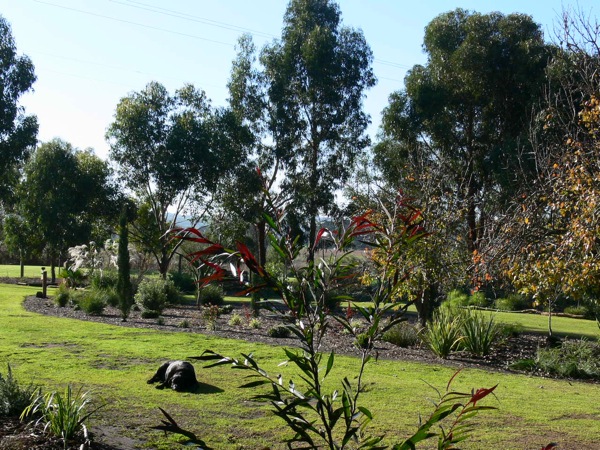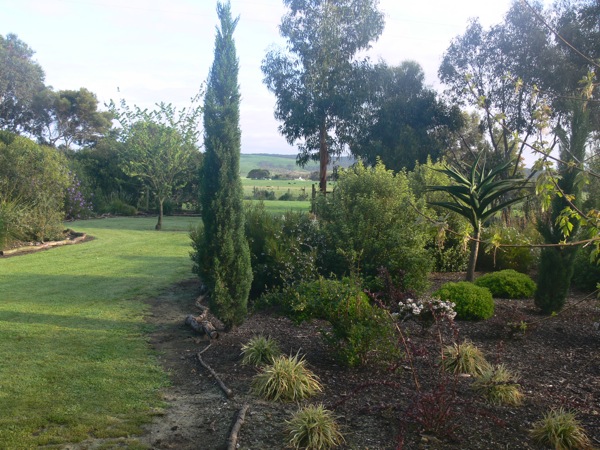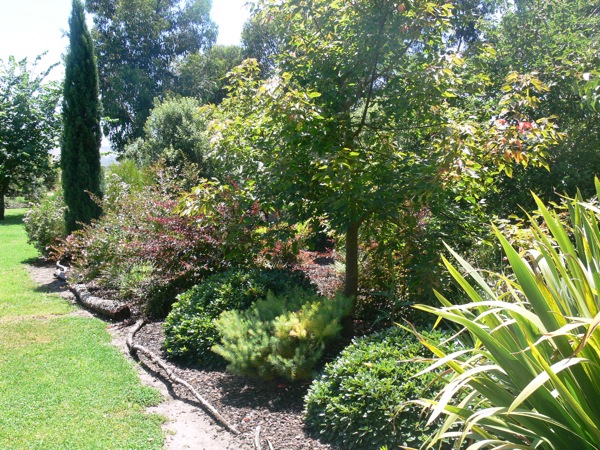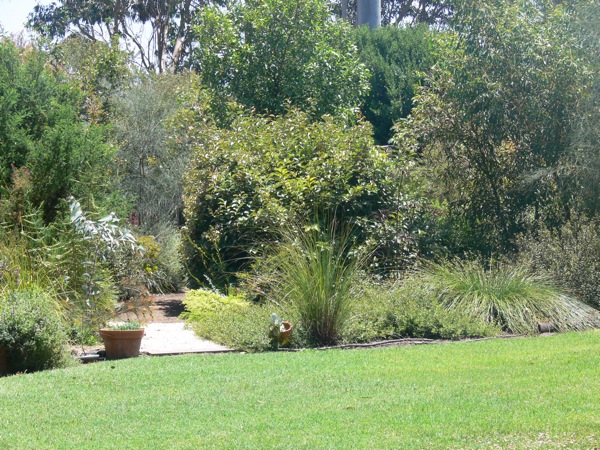This part of the garden was almost devoid of plants with the exception of two fruiting pear trees, a small, badly shaped elm (presumably grown from a sucker)and various large gum trees on our far northern boundary.

Early days, with Archibald our black labrador and various large gum trees on our far northern boundary.
These gums include Eucalyptus grandis, E. viminalis, a couple of Box Gums which are hard to identify because the leaves are always being eaten (? one of our many koalas) and never seem to flower/fruit, and Eucalyptus globulus.
It is a pity that these large trees are on the northern boundary because during winter the area to their south is perpetually shrouded in shade; large trees are better in the southern aspect of a property, but they were there when we purchased the property. As a tree lover, and especially indigenous trees, I couldn’t remove them, even though they are ‘trimmed’ every couple of years by Powercorp to keep them clear of a main power line running parallel with our back fence.

Early planting of the central area, Oct 2010
The area is about half an acre in size, with an existing large shed on site. It is a flat area and so drainage was a possible concern when I first started planning the site. Beyond our north-eastern boundary is a large naturally occurring wetland. The real estate agent informed me that our bottom area has been prone to occasional flooding and asked whether this would be an issue. Why? Having lived through the drought in South Australia, the sight of water was a joy to behold! I was delighted at the prospect that a small section on our NE boundary could be inundated with water, so much so that I have actually put plants in this corner that will tolerate being periodically flooded. These include Phragmites australis, Casuarina obesa, Callistemon rugulosus, Banksia occidentalis and Melaleuca styphelioides; they are all doing remarkably well.

Central section of the bottom garden today
The soil in the bulk of the area is alluvial over mottled light brown clay; there is a degree of pebble in the clay. On the opposite side of this area the soil is sandier – I would assume any clay would be deeper – I haven’t found it yet, and yet water can sit around for a while after a heavy rain, which suggests that clay is present. This opposite side, which is in the western aspect of the garden has proven difficult with plant selection.
The history of this site is important – why do plants repeatedly fail or look poorly in this western part of the garden? The answer I feel lies in the use of the site by the previous owners. It is unfortunate that a lot of people burn their rubbish on-site. It occurs all the time in backyards where there is room to pile up rubbish and then burn it. But the consequences to the soil are profound. Burning invariably makes the soil very alkaline – the evidence of this being that plants constantly have a yellowed tinge to their foliage which can blacken on the tips. I cannot undo this problem. I know that this was done, because of the residual evidence of fire when we moved in – I just didn’t realise how detrimental to the soil it is. It is best to work with plants that will grow with these highly alkaline conditions.
As mentioned in an earlier post, my plant selection is not based on flowers or even necessarily foliage. I look for plants that look ‘interesting’ – deeply serrated leaves versus those with a globular leaf; shiny leaf versus matte leaf etc. The eventual shape of the plant is important also – whether it will be rounded with growth to the ground like Lambertia orbifolia or sparse and open like Melaleuca lateritia.

Early planting of the difficult western section
Foliage colour is also important, especially in a native garden. Some of the greys are really worth seeking out. I have planted Eucalyptus cinerea, the Argyle Apple which is growing like a weed it is doing so well; such an excellent plant for picking the foliage for the vase. Even the rather drab grey-green of the Allocasuarina verticillata is spectacular. The wispiness of the foliage is eerie on windy days but it is one of the real joys in my garden. I have planted it next to the existing elm, which we left in situ and is now doing really well. The large leaf contrasts well with the fine sheoak foliage.
The layout of the area was dictated by the entrance gate and the access to 2 doors of the shed. When we purchased the property in June nearly 4 years ago, the bulk of this area was mowed kikuyu and native couch. So getting rid of the kikuyu and couch has been the most challenging part of the whole gardening process and remains ongoing.

Western corner of the bottom garden today
The site now has a large central garden, around which we can drive vehicles on lawn, which is planted with a mixture of native and exotic plants. These include Berberis thunbergii ‘Superb’, Abelia grandiflora, Pittosporum tobira ‘Wheeler’s Dwarf’ Miscanthus transmorrisonensis, Elegia capensis and Chondropetalum tectorum now known as Elegia tectorum. In between I have mixed plants like Calothamnus villosus for its textural variation with the dwarf Pittosporum and variegated Ophiopogon jaburan.
I had planted the white flowering crepe myrtle ‘Natchez’ in the top garden; it had been in a pot for a while and I was desperate to plant it out and the bottom garden was not ready for planting. It failed to thrive in the top area possibly because of the limestone subsoil and so last winter we transplanted it in the bottom garden. Because of the clay base, it is doing well despite the relocation and by next summer should have settled down well.

Looking south from the back gate
Around the periphery of the lawned driveway are garden beds with meandering paths through predominantly native plantings. Natives didn’t grow well in the garden in the Clare Valley because of the high phosphorus limestone, and so now I am thoroughly enjoying the experience of growing indigenous plants. They just thrive in this coastal garden and bring so many different birds throughout the year.
Some examples of these native plants are Lambertia inermis, Cordyline stricta, Kunzea baxteri, Kunzea pulchella, various correas, various grass varieties including Gahnia, Banksia varieties which have all done remarkably well, various different Agonis, and Callistemon which also all do well.
Grevilleas have been a disappointment, either because of the winter cold (which is considerable given the proximity to the coast) or possibly because of the burning induced alkalinity. I have not lost many plants, the most frequent of any plant being the Grevillea family. So I now do not try any more – just recognise that it is throwing money away even trying. I now work with what is doing well – but of course I need to recognise also that I am fast running out of room for any more plants.
